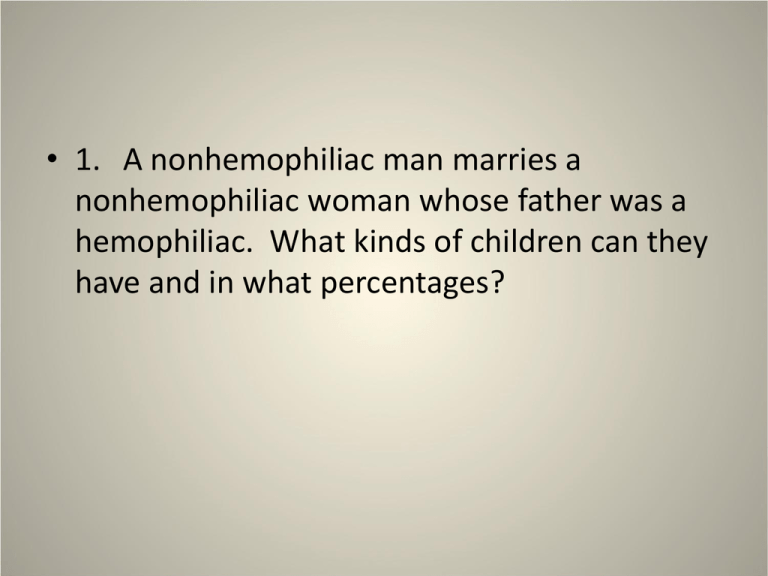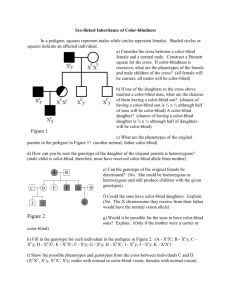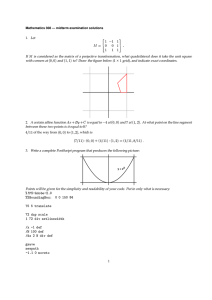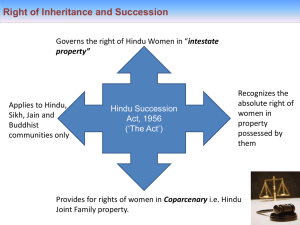
• 1. A nonhemophiliac man marries a
nonhemophiliac woman whose father was a
hemophiliac. What kinds of children can they
have and in what percentages?
Sex –Linked Genetics #1
Step 1: Determine the letters you will use to
represent the alleles. For this one I chose “B”
for normal blood and “b” for the hemophiliac
gene.
Step 2: Determine the alleles of the parents.
The non-hemophiliac man must be XBY. The
non-hemophiliac woman with a hemophiliac
father must be XBXb, because she had to get Xb
from her afflicted father.
Step 3: Set up your Punnett square and do
the cross. Determine the genotypes and
expected percent of each type of child from
the cross.
XB
Y
XB
XB X B
XB Y
Xb
XBXb
Xb Y
25% Normal girl
25% Normal boy
25% Carrier girl
25% Hemophiliac son
• 2. Two normal-visioned parents have a colorblind son. What are the genes of the parents?
What are the chances of their having a color
blind girl? Explain.
Sex-Linked Genetics #2
Step 1 : Choose your alleles. I will use “C” for normal color vision and “c”
for the red/green color blind condition.
Step 2 : Determine the genotypes of the parents. Both parents have
normal vision, yet they have a color-blind son. Because, the dad can not
have the “c” allele (it’s sex-linked remember and he has normal vision)
the wife must be a carrier. Dad = XCY and Wife= XCXc
Step 3 : Set up your Punnett square and do the cross!
XC
Y
XC XCXC
XCY
C
c
XX
c
XY
c
X
There are no chances of this couple having a
color blind girl. The father would have to be
color blind to contribute the second defective
Xc allele needed to produce a color-blind
daughter.
• 3. A normal-visioned man marries a normalvisioned woman whose father was color-blind. They
have two daughters who grow up and marry. The
first daughter has five sons, all normal-visioned. The
second daughter has two normal-visioned daughters
and a color-blind son. Diagram the family tree,
including the genes of all the people mentioned.
Sex-Linked Genetics #3
Step 1 : As this is another problem about color blindness, we already have our
alleles ready from the previous problem. “C” for normal vision, “c” for the
red/green color blind condition. Use what you know from the problem to assign
genotypes and do Punnett square crosses to help answer all the questions. A family
pedigree might be a great way to show clearly the genes of all the people
mentioned.
Step 2 : Figure out the genotypes of the parents. Both have normal vision, so
the man must be XCY . The woman’s father was color blind she has at least
one daughter who has a color blind son. That son had to get his Xc from his
mom who had to get it from her mom. So, the woman must be a carrier.
(XCXc)
Step 3 : Do the crosses. Explain the expected
genotypes of all the people involved.
XC
XC
Xc
Mom
Y
XCXC
XCXc
XCY
XcY
Grandpa
Dad
Xc
Y
XC
XCXc
XCY
XC
XCXc
XCY
These are their possible offspring. Mom’s dad was color
blind, so she got her Xc from him. (see cross above) The
problem says they had two daughters, so we will focus
on them. One daughter had 5 sons, all with normal
vision. She must not be the carrier daughter, otherwise
odds are she would have had a color-blind son. Do we
know if her husband is color blind or not? The other
daughter had 2 normal vision daughters and 1 colorblind son, so she must be a carrier of the Xc allele.
The first daughter would have the genotype, XCXC and all her sons
would be XCY and they would have normal vision. If her husband
was color- blind it would only effect their daughters, (50% would be
expected to be color-blind) but, because they had no daughters
we have no way of knowing from this information if he is color-blind
or not. (see grandpa to see a Punnett square for this situation.)
The second daughter would have to be the carrier. Her daughters have
normal vision. However, one or both of them could be carriers of the trait.
The son, however, was not so lucky and got the defective X. With no
second X to mask the effects, he will be color-blind.
XC
Y
XC
Normal
vision
Normal
vision
Xc
Carrier
Color-blind
son
Pedigree for this family
?











